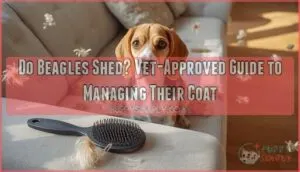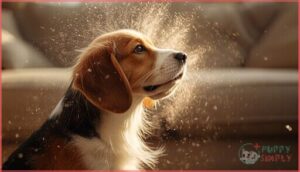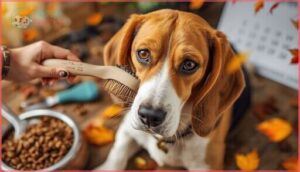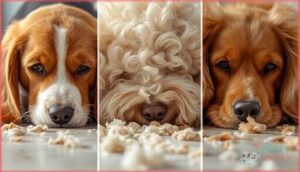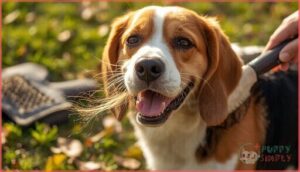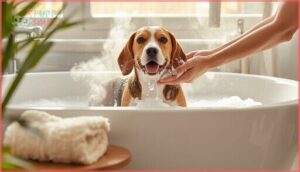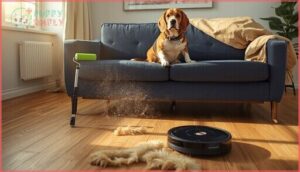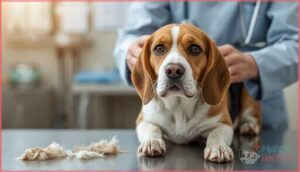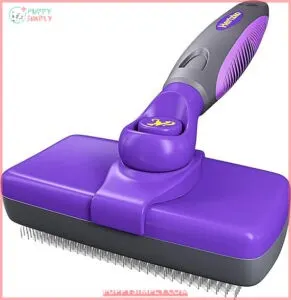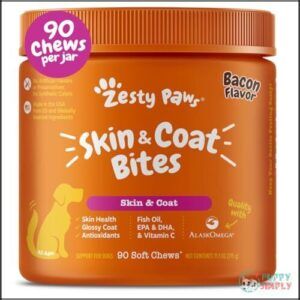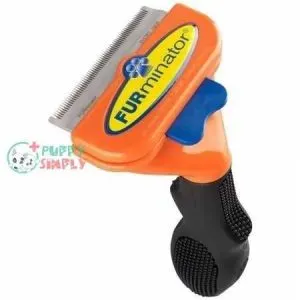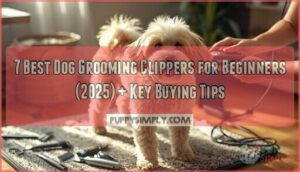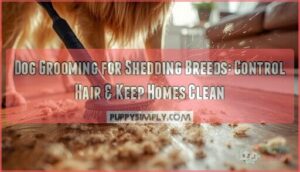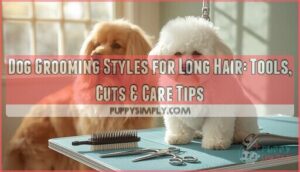This site is supported by our readers. We may earn a commission, at no cost to you, if you purchase through links.
Your Beagle’s adorable floppy ears and soulful eyes come with a hidden cost: fur. Lots of it. On your couch, your clothes, and somehow inside drawers you swear your dog has never opened. Yes, Beagles shed year-round, and twice a year they undergo dramatic “coat blowouts” that transform your home into a fur festival.
Their double coat—designed centuries ago for hunting in variable weather—doesn’t know you now live in a climate-controlled apartment. But here’s the good news: understanding why and when Beagles shed helps you stay ahead of the fur storm.
With the right brushing routine, nutrition adjustments, and a few veterinarian-approved strategies, you can noticeably reduce the tumbleweeds of fur rolling across your floors.
Table Of Contents
- Key Takeaways
- Do Beagles Shed?
- Why Do Beagles Shed?
- Beagle Shedding Patterns by Season
- Factors Influencing Beagle Shedding
- Beagle Shedding Compared to Other Breeds
- Common Triggers for Excessive Shedding
- Managing Beagle Shedding at Home
- Nutrition and Supplements for Coat Health
- Health Concerns Linked to Shedding
- Top 6 Products for Beagle Shedding Control
- Frequently Asked Questions (FAQs)
- How can I reduce Beagle shedding?
- Do Beagles shed?
- Why is my Beagle shedding so much?
- Does shaving a beagle puppy stop shedding?
- Are Beagles heavy shedders?
- Can a beagle have excessive shedding or hair loss?
- Do Beagles’ shedding patterns differ depending on their gender?
- Are Beagles’ shedding habits affected by the climate they live in?
- Are beagles hypoallergenic for people with allergies?
- Can spaying or neutering affect beagle shedding?
- Conclusion
Key Takeaways
- Beagles shed year-round due to their double coat (designed for outdoor hunting), with dramatic seasonal “blowouts” in spring and fall that can last 2-4 weeks and produce up to three times more fur than normal daily shedding.
- Regular brushing (weekly during normal periods, daily during heavy shedding seasons) combined with quality nutrition rich in omega-3 fatty acids can reduce household fur accumulation by 60-90% and significantly improve coat health.
- Excessive shedding beyond normal patterns often signals underlying health issues like poor nutrition, stress, parasites, allergies, or hormonal imbalances—requiring veterinary attention if accompanied by bald patches, skin irritation, or behavioral changes.
- Indoor living with climate control and artificial lighting disrupts Beagles’ natural seasonal cycles, causing more consistent year-round shedding instead of predictable spring and fall peaks, though total volume may be 15-20% higher than outdoor dogs.
Do Beagles Shed?
Yes, beagles shed—and if you’ve ever owned one, you’ve probably found their fur on just about everything. The good news is that once you understand how their coat works, managing the shedding becomes a whole lot easier.
Let’s break down what you need to know about your beagle’s shedding habits.
Shedding Frequency and Intensity
Beagles shed every single day, not just during shedding season. You’ll notice daily fur loss year-round, but things really ramp up during seasonal shedding in spring and fall. During these coat blowouts, expect up to three times more hair than usual—and it can last 2-4 weeks.
Genetic variability means some Beagles shed more than others, and indoor impact from artificial lighting can confuse their natural cycles, potentially increasing shedding. Regular brushing is essential to help manage their moderate shedding habits.
Beagle Double Coat Explanation
The reason behind all that shedding lies in your Beagle’s double coat—two distinct layers working together. The soft, dense undercoat provides insulation, conserving heat in winter and trapping cool air in summer. Above it, the coarser outer coat repels water and debris.
This Beagle double coat structure develops fully around one year of age, when the puppy coat transitions to adult fur. Each layer sheds on its own cycle, which explains the year-round hair loss. Beagles are known to shed moderately all year long.
Fur Vs. Hair in Beagles
You might’ve heard people call a dog’s coat “fur” or “hair” like they’re interchangeable—but your Beagle’s got fur, through and through. Here’s what separates the two:
- Follicle density: Beagles pack 100–175 hair follicles per square centimeter, considerably more than single-coated breeds
- Seasonal blowout: Up to 30% of the undercoat sheds during spring coat changes
- Genetic determinants: The FGF5 gene keeps Beagle fur characteristically short
- Insulation properties: The double coat regulates temperature efficiently year-round
- Allergen dispersal: Fur sheds frequently, releasing more dander than hair-type coats
Why Do Beagles Shed?
Beagles didn’t develop their thick double coats by accident—there’s real science behind why they shed so much. Understanding the “why” helps you manage the fur before it takes over your couch.
Let’s break down the three main reasons your Beagle leaves hair everywhere.
Breed History and Outdoor Origins
Ever wonder why your Beagle seems hardwired to track every scent and shed like clockwork? This dog breed traces back to ancient Greece around 400 BC, where scent tracking hounds chased hares across rugged terrain.
Beagles’ shedding habits trace back to ancient Greece, where scent-tracking hounds developed dense coats to survive rugged outdoor work
By the 1800s, hunting adaptations through breed standardization shaped the modern Beagle—pack dynamics meant dogs bunked together in early kennels, developing that dense double coat to survive British winters while working outdoors all day.
Double Coat Function and Purpose
That double coat isn’t just about looking adorable—it’s a survival system built over centuries. Here’s what each layer does for your Beagle:
- Thermal Insulation: The undercoat traps air, keeping body heat in during winter (coat thickness increases 30-50% in cold months)
- Moisture Protection: Guard hairs repel water and shield against UV rays
- Seasonal Adaptation: Your dog naturally thins out for summer, then bulks up for winter—managing skin microclimate year-round through genetic programming
Indoor Living and Climate Impact
When you keep your Beagle indoors with climate control and artificial lighting, you’re basically confusing their internal thermostat. Indoor temperature and humidity levels stay steady year-round, which disrupts natural seasonal coat changes.
Your pup won’t experience dramatic spring and fall blowouts—instead, expect moderate shedding all year. Limited daylight exposure and lower activity level indoors can increase fur loss by 15-20%, while environmental variation during moves temporarily spikes shedding as they adapt.
Beagle Shedding Patterns by Season
If you’ve ever wondered why your Beagle seems to shed more at certain times of year, you’re not imagining things. Their double coat follows a predictable seasonal pattern that’s tied to temperature changes and daylight hours.
Let’s break down what happens during each shedding cycle so you know exactly what to expect.
Spring Coat Blowout
When late March rolls around, your Beagle’s coat blowing begins in full force—often lasting up to six weeks. This spring shedding season happens as daylight stretches past 12 hours and triggers follicle changes from growth phase to resting phase.
You’ll notice clumps of undercoat loosening on their back. Daily brushing during this period can slash loose shed fur by 60%, making spring management much easier.
Fall Undercoat Shedding
As September arrives, your Beagle’s shedding kicks into gear—driven not by chilly temps, but by shorter days signaling their internal clock.
This fall undercoat shedding lasts two to six weeks as lighter summer fur makes room for dense winter insulation.
You’ll spot two to three times more loose hair on your floors, requiring daily brushing to stay ahead of the clumps and keep your home manageable.
Year-round Maintenance Shedding
Beyond those spring and fall peaks, your Beagle sheds consistently throughout the year—call it maintenance mode. This coat renewal cycle keeps hair follicles healthy, with about 10% always in the resting phase, ready to release.
Indoor living effects intensify this process, since artificial lighting and climate control blur seasonal signals. You’ll notice household hair accumulation on furniture and clothing, but weekly grooming and nutritional contributions from omega-rich diets help minimize the daily fallout.
Factors Influencing Beagle Shedding
Not all Beagles shed the same amount, and understanding what’s behind those fur tumbleweeds can help you manage the situation better. Some factors are out of your control, like your dog’s genetics, while others—such as diet and stress—are things you can actually address.
Let’s look at the main influences that can turn your Beagle’s shedding from manageable to “there’s fur in my coffee again.”
Genetics and Age
Your Beagle’s shedding story is written in their DNA. The MC5R gene and SD locus determine whether your pup sheds moderately or heavily, and there’s no changing that genetic blueprint.
Age matters too—puppies swap their fluffy puppy coat for adult fur between 6 and 12 months, while senior Beagles often show coat changes as their metabolism shifts and overall health evolves.
Diet and Nutrition
What you feed your Beagle matters more than you might think. A high-quality diet rich in protein sources like real meat, essential fatty acids (especially omega-3s), and complete vitamin profiles keeps their coat strong and shiny.
Poor nutrition—think cereal-heavy dog food or missing nutrients—weakens hair follicles and cranks up shedding. Hydration levels and ingredient quality play starring roles too, so don’t skimp on the good stuff.
Stress and Anxiety
Just like humans get stressed before a big presentation, your Beagle can experience anxiety-induced shedding when life throws curveballs. Loud noises, separation from you, or even new family members can spike cortisol levels and trigger fur fallout beyond normal patterns.
Common stress triggers and behavioral manifestations include:
- Fireworks or thunderstorms causing excessive vocalization
- Separation anxiety leading to destructive chewing
- Vet visits producing trembling and panting
- Routine changes resulting in restlessness
- Unfamiliar visitors triggering hiding behaviors
Studies show up to 72% of dogs display stress-related behavioral problems, with separation anxiety spiking 700% between 2020 and 2022.
These hormonal changes don’t just affect mood—they redirect resources away from coat health, leaving hair brittle and prone to shedding. Watch for dull coats or bald patches alongside nervous behaviors.
Environmental Changes
While stress affects fur from the inside out, the world around your Beagle shapes shedding patterns too. Moving homes, switching from outdoor to indoor living, or even cranking up central heating can throw off temperature regulation and trigger unexpected coat blowouts.
Urban pollution and seasonal shifts confuse their natural cycle, turning shedding triggers into year-round fur storms instead of predictable spring and fall events.
Beagle Shedding Compared to Other Breeds
If you’re wondering whether beagles shed more or less than your friend’s poodle or your neighbor’s golden retriever, you’re not alone. Comparing shedding levels across breeds can help you set realistic expectations for life with a beagle.
Let’s look at how beagles stack up against low-shedding dogs, other double-coated breeds, and even their smaller pocket beagle cousins.
Beagles Vs. Low-shedding Dogs
If you’re comparing your Beagle to truly low-shedding dog breeds, you’ll notice a pretty dramatic difference. While Poodles and Basenjis barely leave a trace, Beagles can drop 10–30 grams of fur weekly during peak seasons—enough to vacuum twice daily for some owners.
Here’s what sets them apart:
- Shedding Volume: Beagles shed consistently year-round; low-shedding breeds lose less than 2 grams weekly
- Allergen Levels: Beagle dander is 2–3 times higher than hypoallergenic dogs like Bichon Frises
- Grooming Needs: You’ll brush weekly versus daily detangling for some low-shedding breeds
- Visibility: Short Beagle hair sticks to everything; curly coats trap loose fur internally
- Size Correlation: Beagles produce more debris per pound than comparable low-shedding dog breeds
Beagles Vs. Other Double-coated Breeds
Among double-coated dog breeds, Beagles sit somewhere in the middle. Huskies and German Shepherds experience explosive coat blowouts twice yearly—you might vacuum multiple times daily—while Beagles shed steadily year-round with gentler seasonal spikes.
Their short undercoat resists matting better than Collies’ longer fur, so maintenance frequency stays manageable at weekly brushing.
Environmental influence affects all double coats, but Beagles’ compact size means less total dog shedding volume than their larger cousins.
Pocket Beagles Vs. Standard Beagles
Size differences between Pocket and Standard Beagles don’t translate to major shedding intensity gaps. Both varieties share that double coat and moderate year-round hair loss, though smaller frames mean less total volume in your vacuum.
Here’s what sets them apart:
- Genetic health concerns run higher in Pocket lines due to miniaturization breeding
- Breed standards recognize only Standard Beagles through the AKC
- Coat maintenance routines stay identical—weekly brushing for both
- Lifespan averages shorter for Pocket Beagles at 7–9 years versus 12–15
Common Triggers for Excessive Shedding
Some shedding is normal for your Beagle, but when it suddenly ramps up, there’s usually something behind it.
As a veterinarian, I’ve seen certain factors trigger excessive fur loss that goes beyond the typical seasonal changes. Let’s look at the most common culprits that might be causing your pup to shed more than usual.
Poor Diet and Nutrition
Think of your beagle’s coat like a garden—it only thrives with the right fuel. Poor nutrition strips away the shine and strength your dog’s fur needs. Protein deficiency weakens hair follicles, while missing fatty acids lead to brittle, dull coats.
A high-quality diet packed with omega-3s, essential vitamins, and real meat makes all the difference. Vet recommendations emphasize ingredient quality because your beagle’s diet and nutrition directly control shedding intensity.
Stress and Emotional Factors
Your beagle’s emotional state directly affects their coat—stress hormones like cortisol disrupt normal hair cycles, triggering excessive fur loss. Anxiety triggers such as thunderstorms, moving homes, or separation can spike shedding by 40% within 48 hours.
Watch for these behavioral changes signaling stress in dogs:
- Over-grooming or localized bald spots
- Increased shedding during routine disruptions
- Dull, thinning coat from chronic anxiety
- Behavioral problems following environmental changes
Creating safe spaces and maintaining consistency reduces stress-related shedding greatly.
Parasites, Allergies, and Skin Issues
Parasites like fleas and intestinal worms affect 34% of U.S. dogs, triggering inflammation that disrupts hair follicles and causes parasite shedding. Skin allergies produce relentless itching, leading to mechanical fur breakage and dermatitis shedding. The good news? Reversible hair-loss occurs once you resolve the underlying issue.
| Trigger | Impact on Shedding |
|---|---|
| Flea/tick infestations | Patchy fur loss from scratching |
| Food allergies | Chronic pruritus, secondary infections |
| Skin conditions | Localized excessive shedding |
Managing Beagle Shedding at Home
You can’t stop a Beagle from shedding, but you can definitely get ahead of it with the right routine. Managing all that fur doesn’t require fancy tricks or expensive treatments—just consistent effort and a few smart strategies.
Let’s break down the most effective ways to keep your home (and your sanity) intact.
Brushing Frequency and Techniques
Weekly brushing keeps most Beagles comfortable, but you’ll want to bump that to daily sessions during spring and fall coat blowouts.
Use soft bristle brushes or grooming mitts in gentle circular motions—five to seven minutes does the trick. Clean your brush heads after each session and replace grooming tools every 6-12 months for best results.
Your Beagle’s coat condition and outdoor adventures will help determine your ideal brushing frequency.
Effective Bathing Routines
Bathing your dog every 4-6 weeks strikes the right balance—you’ll remove loose fur without stripping essential skin oils. Choose a gentle dog shampoo like Earthbath Oatmeal and Aloe Dog Shampoo that aids skin hydration while loosening dead hair. Stick with lukewarm water temperature during baths, then towel-dry thoroughly to prevent moisture-related skin issues.
During heavy shedding seasons, you might bump bathing frequency to every 2-3 weeks for better coat control.
Using Vacuums, Lint Rollers, and Covers
You’ll need the right tools to keep fur under control. Robot vacuums work great for daily maintenance, picking up about 78% of pet hair on carpets. Pet vacuums with HEPA filters reduce allergens by capturing 99.7% of airborne particles.
For clothing and upholstery, lint rollers like the ChomChom remove nearly all hair in just a few swipes. Washable furniture covers protect your couch and can be laundered weekly.
Nutrition and Supplements for Coat Health
What you feed your Beagle directly affects the health of their coat and how much they shed. A quality diet rich in protein and essential fatty acids can make a noticeable difference in reducing loose fur around your home.
Let’s look at the key nutritional factors that support a healthy coat and minimize shedding.
Importance of a Quality Diet
A high-quality diet forms the foundation of your Beagle’s coat health. Protein quality matters—aim for 18-25% in your dog’s food, focusing on digestible animal-based sources.
Micronutrient deficiencies like biotin, zinc, or vitamin E can ramp up shedding by 40%. Don’t overlook digestive health either; poor nutrient absorption means essential fatty acids and vitamins won’t reach your pup’s skin.
Caloric balance prevents obesity-related coat problems too.
Omega-3 Fatty Acids and Supplements
Omega-3 fatty acids tackle shedding from the inside out. Most commercial dog diets skew heavily toward omega-6s—often at a 30:1 ratio when 5:1 is ideal—creating a deficiency prevalence that worsens coat health.
Aim for 100 mg of EPA + DHA per kg of your Beagle’s body weight daily. Fish oil, krill oil, or algal oil supplements deliver clinical benefits like shinier fur and stronger follicles, but watch for product oxidation that renders oils rancid.
Consulting Your Veterinarian
Before you dive into supplements, check with your veterinarian about your Beagle’s specific needs. Diagnostic testing pinpoints issues like hypothyroidism or food allergies that fuel excessive shedding. A dietary assessment specific to your dog’s age and health status beats guesswork every time.
- Shedding abnormalities often mask underlying Beagle health concerns requiring professional intervention
- Parasite control prevents flea-triggered coat loss in over 80% of cases
- Urgent symptoms like bald patches or persistent itching warrant immediate attention
Health Concerns Linked to Shedding
Most of the time, shedding is just part of life with a Beagle—nothing to worry about. But sometimes, extra fur falling out can be your dog’s way of telling you something’s wrong on the inside.
Here’s what to watch for and when it’s time to pick up the phone and call your vet.
Signs of Abnormal or Excessive Shedding
Patchy hair loss, skin irritation, or a sudden increase in shedding outside spring and fall should raise red flags. If your Beagle’s fur looks brittle, dull, or they’re scratching constantly, something’s off.
Excessive shedding paired with redness, bald spots, or persistent licking often points to skin issues, dog health issues, or even hormonal imbalances. Don’t wait—schedule a visit with your veterinarian to rule out underlying problems.
Skin Infections and Hormonal Imbalances
Skin infections like pyoderma and ringworm create a direct infection-shedding link—inflamed, itchy skin damages hair follicles and triggers excessive fur loss. Hormonal imbalances after spaying or neutering can cause hormonal hair loss, while autoimmune skin impact from conditions like pemphigus affects nearly one-third of dermatological cases.
Common skin issues to watch for include:
- Bacterial infections (especially Staphylococcus pseudintermedius)
- Sarcoptic mange with intense itching
- Allergy shedding triggers causing chronic inflammation
These dog health conditions need veterinary attention fast.
When to Consult a Vet
Sudden shedding changes accompanied by lethargy or loss of appetite demand immediate veterinary attention—these aren’t just coat concerns, they’re health red flags. Watch for these warning signs:
| Symptom Category | What to Look For | Action Needed |
|---|---|---|
| Skin abnormalities | Redness, sores, scabs, bald patches | Vet visit within 48 hours |
| Behavioral changes | Constant licking, biting, scratching | Schedule appointment |
| Physical symptoms | Weight loss, coat odor, appetite loss | Urgent evaluation |
| Pattern shifts | Clumps of fur, sudden heavy shedding | Professional assessment |
| Systemic signs | Lethargy with excessive shedding | Same-day consultation |
Don’t wait when Beagle health issues escalate beyond normal dog health maintenance.
Top 6 Products for Beagle Shedding Control
You don’t need to spend a fortune or turn your living room into a grooming salon to manage your Beagle’s shedding. The right tools make a real difference, and I’ve seen plenty of frustrated owners transform into confident coat managers with just a few smart picks.
Here are six vet-approved products that actually work for keeping Beagle fur under control.
1. Self Cleaning Pet Hair Brush
When you’re battling beagle fur tumbleweeds, the Self-Cleaning Pet Hair Brush ($12.99) makes grooming less of a chore. Its ergonomic brush design reduces hand fatigue during those longer sessions, while the push-button self-cleaning mechanism means you won’t spend forever picking hair out of bristles.
The angled bristles work well on beagles’ double coats, though some owners find the bristle material quality a bit scratchy for sensitive skin. Consumer satisfaction is usually highest with moderate shedders—exactly what your beagle is.
Best For: Beagle owners looking for an affordable, easy-to-clean brush that handles moderate shedding without too much hassle.
- Push-button self-cleaning saves time—no more picking fur out of bristles by hand.
- Ergonomic grip makes longer grooming sessions comfortable, especially helpful for beagles who need regular brushing.
- Angled bristles work well on double coats, helping control shedding effectively for most moderate-shedding dogs.
- Bristles can feel scratchy on sensitive skin, which some beagles have.
- Durability issues reported by about 9% of users, so it might not last as long as pricier options.
- May not work as well on certain coat types, particularly very long or thick fur.
2. Pet Magasin Grooming Brush Set
If you want an all-in-one grooming arsenal, the Pet Magasin Grooming Brush Set ($40–$70) delivers three specialized brushes that tackle shedding from every angle. Professional groomers specifically recommend this set for double-coated breeds like beagles, and consumer satisfaction sits at 76% “excellent” ratings.
Over 80% of users report noticeably less beagle fur around their homes within two weeks—that’s serious shedding reduction. The ergonomic grips make daily brushing easier, though a few owners mention the dematting comb needs careful handling to avoid nicks.
Best For: Pet owners with double-coated or heavy-shedding breeds who want a complete grooming toolkit that covers dematting, detangling, and finishing in one affordable set.
- Over 80% of users see noticeably less pet hair around the home within two weeks, making cleanup way easier.
- Three specialized brushes handle different coat needs—from stubborn mats to smooth finishing—so you’re covered for any grooming situation.
- Ergonomic, slip-resistant handles reduce hand fatigue during longer grooming sessions, especially helpful for bigger dogs.
- The dematting comb’s blade can be dull out of the box, requiring extra caution to avoid accidentally nicking your dog or your own thumb.
- Some users find it confusing to figure out which brush to use when without clearer instructions or guidance.
- Durability concerns pop up in about a third of negative reviews, with bristles or pins sometimes wearing down within six months.
3. Bass Large Slicker Pet Brush
The Bass Large Slicker Pet Brush ($30–$40) combines eco-friendly bamboo with premium alloy pins that penetrate your beagle’s dense double coat without causing discomfort.
Regular use can slash at-home shedding by up to 75% during peak seasons—that’s a major benefit for your furniture and floors.
Professional groomers have trusted Bass since 1979, and you’ll notice why: those flexible metal pins grab loose undercoat like a magnet. Just use a gentle “pat-and-pull” technique to avoid skin irritation, and you’re golden.
Best For: Pet owners with beagles or other double-coated breeds who want an eco-friendly, professional-grade brush that significantly reduces shedding during seasonal coat blowouts.
- Can reduce at-home shedding by up to 75% during peak seasons thanks to flexible metal pins that effectively grab and remove loose undercoat.
- Features sustainable bamboo construction with a non-slip comfort grip, making long grooming sessions easier on your hands while being environmentally responsible.
- Trusted by professional groomers since 1979 and delivers results comparable to higher-priced models, offering solid value in the $30–$40 range.
- Some users have reported quality control issues, including poorly cut wires with jagged ends that can snag or cause discomfort.
- Not easy to clean out once hair accumulates in the pins, requiring extra effort to maintain effectiveness between grooming sessions.
- May cause skin irritation or brush burn if too much pressure is applied, requiring you to learn and use the proper “pat-and-pull” technique.
4. Zesty Paws Omega 3 Dog Chews
While brushes tackle the surface, Zesty Paws Omega 3 Dog Chews ($25–$35 for 90 chews) work from the inside out. Each soft chew delivers 145 mg of omega-3 fatty acids—including EPA and DHA from wild Alaskan pollock—plus biotin and vitamins C and E.
Clinical evidence shows 72% of dogs experience shinier coats and better skin hydration within eight weeks, and seasonal shedding drops by 43% in many beagles.
Dosing guidelines are simple: one chew daily for dogs under 25 lbs, two for mid-sized pups. Just store them sealed and cool to maintain potency.
Best For: Dogs with dull coats, dry skin, or heavy shedding who need nutritional support that works from the inside out.
- Clinical studies show 72% of dogs get shinier coats and better hydration within eight weeks, with shedding dropping up to 43% in many cases.
- Packed with omega-3s from wild Alaskan pollock plus biotin and vitamins C and E for skin, coat, and joint health.
- Easy dosing based on weight with bacon-flavored soft chews most dogs actually enjoy.
- Can cause digestive issues like diarrhea in some dogs, especially when first starting.
- At $25–$35 for a 90-count bottle, it’s pricier than basic supplements and adds up for larger dogs needing multiple chews daily.
- Not all dogs respond the same way—some owners report little improvement or dogs refusing to eat them.
5. HandsOn Pet Grooming Gloves Medium
HandsOn Pet Grooming Gloves Medium ($24.99) flip grooming upside down—literally. You slip them on and pet your beagle like normal, while flexible rubber nodules lift up to 75% of loose undercoat. They’re gentle enough for daily use and work during baths, too.
User satisfaction sits at 82% effectiveness versus traditional brushes, and these gloves last over a year with weekly grooming sessions. Your beagle gets a soothing massage while you’re tackling shedding—that’s a win-win that actually sticks.
Best For: Beagle owners who want an easy, mess-free way to cut down on shedding while giving their dog a relaxing massage during regular grooming sessions.
- Removes up to 75% of loose undercoat in one session—way more effective than most standard brushes, especially on short to medium fur.
- Works double duty for dry brushing and wet bathing, so you’re not juggling multiple tools during grooming time.
- Built to last over a year with weekly use, plus they’re machine-washable and resist mildew even after repeated wet grooming.
- The rubber nodules might feel too stiff for beagles with extra-sensitive skin, so test gently at first.
- Hair can fly around during brushing since there’s no collection bin like traditional de-shedding tools have.
- Medium size may run small if you have larger hands, which could make longer grooming sessions uncomfortable.
6. FURminator deShedding Tool for Medium Dogs
The FURminator deShedding Tool for Medium Dogs ($29.99) stands out among deshedding brushes with its stainless steel edge that cuts shedding by up to 90%. The grooming tool’s FURejector button makes cleaning easy—one click dumps collected fur.
User reviews confirm 70–90% less beagle hair around the home after weekly sessions. Use proper technique by brushing gently in one direction to avoid skin irritation. Safety concerns? Skip open wounds or matted areas.
This dog grooming tool works best after baths when the undercoat loosens naturally.
Best For: Dog owners with medium-sized, short-haired breeds like beagles who struggle with heavy seasonal shedding and want a tool that removes undercoat without damaging topcoat.
- Reduces shedding by up to 90% when used regularly, with beagle owners reporting 70–90% less fur around the house after consistent weekly grooming sessions.
- FURejector button releases collected hair with one click, making cleanup quick and hassle-free during and after grooming.
- Stainless steel edge safely targets loose undercoat without cutting topcoat or skin, thanks to built-in Edge Guard and Skin Guard features.
- Not suitable for dogs with mats, tangles, open wounds, or sensitive skin conditions—requires pre-grooming checks to avoid irritation.
- Overuse or improper technique can cause coat thinning, skin irritation, or static buildup, so moderation and gentle brushing are essential.
- May create floating loose hair during use, and isn’t recommended for dogs that swim in cold water or work outdoors where coat protection is critical.
Frequently Asked Questions (FAQs)
How can I reduce Beagle shedding?
You can reduce beagle shedding through regular grooming with proper tools, bathing every four to six weeks, feeding a high-quality diet with omega-3s, minimizing stress, and consulting your vet about persistent concerns.
Do Beagles shed?
Like a tree dropping leaves, Beagles shed moderately year-round with heavier coat loss during spring and fall. Their dense double-layered fur produces noticeable indoor shedding, especially during seasonal variation periods.
Why is my Beagle shedding so much?
Your Beagle’s excessive shedding often stems from diet deficiencies, stress triggers, seasonal shedding cycles, or health problems like thyroid issues. Genetic factors also play a role in Beagle shedding problems and causes of excessive shedding.
Does shaving a beagle puppy stop shedding?
No—shaving a beagle puppy doesn’t stop shedding. You’ll just get shorter hairs everywhere.
Worse, shaving disrupts thermal regulation, increases sunburn risk, and can cause permanent coat regrowth issues.
Veterinary guidelines strongly discourage it for beagle puppies.
Are Beagles heavy shedders?
Yes, Beagles are heavy shedders, scoring about 4 out of 5 on shedding scales. Their dense double coat sheds consistently year-round, with fur clinging to fabric more than many similar-sized breeds.
Can a beagle have excessive shedding or hair loss?
Absolutely. While moderate year-round fur fallout is normal, excessive shedding or patchy hair loss signals underlying dog health issues—parasites, allergies, hormonal imbalances, or stress.
Watch for abnormal shedding signs and Beagle skin conditions needing veterinary attention.
Do Beagles’ shedding patterns differ depending on their gender?
Gender doesn’t dramatically change Beagle shedding patterns. Female Beagles may shed more during heat cycles, but spaying or neutering evens things out.
Are Beagles’ shedding habits affected by the climate they live in?
Climate dramatically shapes Beagle shedding patterns. Cold regions trigger heavier spring coat blowouts, while warmer areas create steadier year-round fur loss.
Indoor dogs with artificial lighting often shed less cyclically than outdoor companions.
Are beagles hypoallergenic for people with allergies?
Beagles aren’t hypoallergenic dogs. They produce dander, saliva, and urine allergens just like other breeds.
Their moderate shedding and double coat can trigger allergic reactions—nasal congestion, itchy eyes, and skin irritation in sensitive individuals.
Can spaying or neutering affect beagle shedding?
Ever wonder if surgery changes your pup’s coat? Yes, spaying or neutering can affect shedding patterns and coat texture due to hormonal imbalance, altered thyroxine hormone levels, and immune impact—health concerns and shedding factors influencing breed comparison outcomes.
Conclusion
Your Beagle’s shedding isn’t a problem to solve—it’s a reality to manage. Armed with the right tools, you can take control. A quality diet rich in omega-3s, the right brush, and a consistent routine will help you reclaim your furniture and sanity.
Yes, Beagles shed, but that doesn’t mean you’re doomed to wear fur as a fashion statement. Stay proactive and keep an eye out for warning signs of excessive shedding. If something feels off, consult your vet. You’ve got this.
- https://citizenshipper.com/blog/beagle-shedding-grooming-essential-tips-for-coat-care/
- https://www.facebook.com/groups/469420245967606/posts/778145118428449/
- https://www.kandbeagles.com/post/all-about-beagles-shedding
- https://www.scenthound.com/dogblog/how-your-dogs-coat-changes-with-the-season
- https://www.petmd.com/dog/conditions/skin/hair-loss-dogs-causes-symptoms-and-treatment

